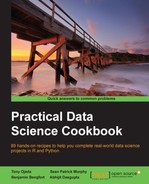Now that we have two different ways to compute a similarity distance between users, we can determine the best critics for a particular user and see how similar they are to an individual's preferences.
Implement a new method for the MovieLens class, similar_critics(), that locates the best match for a user:
import heapq ... def similar_critics(self, user, metric='euclidean', n=None): """ Finds, ranks similar critics for the user according to the specified distance metric. Returns the top n similar critics if n is specified. """ # Metric jump table metrics = { 'euclidean': self.euclidean_distance, 'pearson': self.pearson_correlation, } distance = metrics.get(metric, None) # Handle problems that might occur if user not in self.reviews: raise KeyError("Unknown user, '%s'." % user) if not distance or not callable(distance): raise KeyError("Unknown or unprogrammed distance metric '%s'." % metric) # Compute user to critic similarities for all critics critics = {} for critic in self.reviews: # Don't compare against yourself! if critic == user: continue critics[critic] = distance(user, critic) if n: return heapq.nlargest(n, critics.items(), key=itemgetter(1)) return critics
The similar_critics method, added to the MovieLens class, serves as the heart of this recipe. It takes as parameters the targeted user and two optional parameters: the metric to be used, which defaults to euclidean, and the number of results to be returned, which defaults to None. As you can see, this flexible method uses a jump table to determine what algorithm is to be used (you can pass in euclidean or pearson to choose the distance metric). Every other critic is compared to the current user (except a comparison of the user against themselves). The results are then sorted using the flexible heapq module and the top n results are returned.
To test out our implementation, print out the results of the run for both similarity distances:
>>> for item in model.similar_critics(232, 'euclidean', n=10): print "%4i: %0.3f" % item 688: 1.000 914: 1.000 47: 0.500 78: 0.500 170: 0.500 335: 0.500 341: 0.500 101: 0.414 155: 0.414 309: 0.414 >>> for item in model.similar_critics(232, 'pearson', n=10): print "%4i: %0.3f" % item 33: 1.000 36: 1.000 155: 1.000 260: 1.000 289: 1.000 302: 1.000 309: 1.000 317: 1.000 511: 1.000 769: 1.000
These scores are clearly very different, and it appears that Pearson thinks that there are much more similar users than the Euclidean distance metric. The Euclidean distance metric tends to favor users who have rated fewer items exactly the same. Pearson correlation favors more scores that fit well linearly, and therefore, Pearson corrects grade inflation where two critics might rate movies very similarly, but one user rates them consistently one star higher than the other.
If you plot out how many shared rankings each critic has, you'll see that the data is very sparse. Here is the preceding data with the number of rankings appended:
Euclidean scores: 688: 1.000 (1 shared rankings) 914: 1.000 (2 shared rankings) 47: 0.500 (5 shared rankings) 78: 0.500 (3 shared rankings) 170: 0.500 (1 shared rankings) Pearson scores: 33: 1.000 (2 shared rankings) 36: 1.000 (3 shared rankings) 155: 1.000 (2 shared rankings) 260: 1.000 (3 shared rankings) 289: 1.000 (3 shared rankings)
Therefore, it is not enough to find similar critics and use their ratings to predict our users' scores; instead, we will have to aggregate the scores of all of the critics, regardless of similarity, and predict ratings for the movies we haven't rated.
